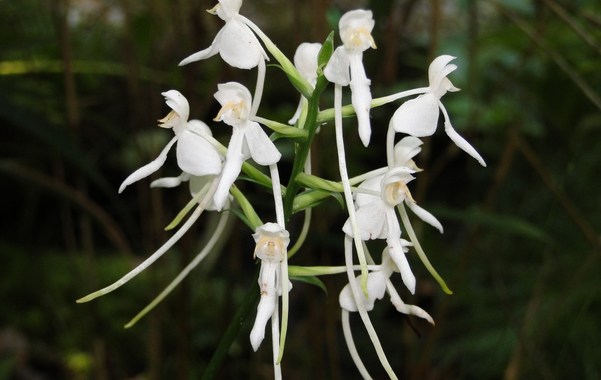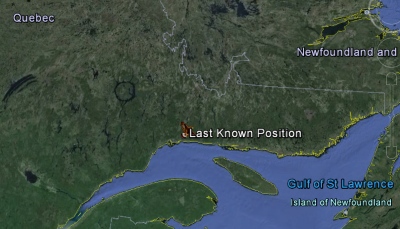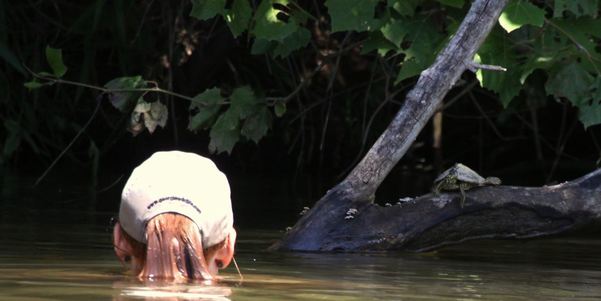
Oscar Dewberry’s first visit to Ossabaw Island was for work ... and it was a pleasure.
In winter 1957-58, Dewberry, a newly hired biologist with what is now Georgia DNR’s Game Management Section, helped capture deer on Ossabaw as part of project to restock whitetails across the state.
The project had a lasting impact on Georgia’s deer population, restoring the herd statewide. The island had a lasting impact on Dewberry, setting him on a 34-year DNR career.
This summer, in his first trip back in a half-century, he and his wife Bobbie toured Ossabaw with The Environmental Resources Network, or TERN, the Nongame Conservation Section friends group.
Dewberry, 87, found “some things ... very similar,” particularly the marshes and roads. “But it was a lot more grown up,” he added, because in the 1950s Ossabaw was still private and home to free-ranging cattle, plus hogs, deer and a few horses.
Each week that winter, except in December, he would leave Metter early on Monday, gather groceries and gas, guide a boat with other staff to Ossabaw, hunt deer at night by Jeep, spotlight and nicotine-filled darts, and crate the captured animals for stocking before leaving on Fridays. Crews stayed in a cabin beside a tidal slough. DNR’s Jack Crockford, developer of the Cap-Chur syringe gun and later the agency’s director, sometimes joined the crew, flying in and out using the beach as a runway.
Dewberry doesn’t recall how many deer they caught. Records show that 428 were stocked in 1957-58 using deer from Ossabaw, Blackbeard and St. Catherines islands, plus Texas and other sites.
He moved on to other projects the next fall, returning to Ossabaw once in 1965, all the while building a career that contributed to key restoration efforts including wild turkeys, Canada geese and wood ducks. He retired in 1989 as supervisor of Game Management's southwest Georgia region, but still works with wildlife. Dewberry, who lives in Bainbridge, serves as a TERN board member, coordinates the Decatur County Audubon Christmas Bird Count and helps mentor young birders. From 1994-2010, he also did surveys and helped in developing the Breeding Bird Atlas of Georgia, now in book form.
Dewberry said his DNR work was a joy. “If I could’ve done it without a salary, I would have.”
And he will always remember Ossabaw, including the February night it snowed and the occasionally harrowing trips to the island in a loaded 17-foot aluminum boat piloted by the new guy more familiar with river bends near his hometown of Tallapoosa than the swirling chop in the island shortcut called Hell’s Gate.
“I have been out there when I wished I wasn’t,” Dewberry said with a chuckle.
Back to top.
 By Terry W. Johnson
In Georgia, you cannot go through the summer without thinking about hurricanes, particularly during the peak of the Atlantic hurricane season, September through early October. Although these giant storms rarely make landfall along our coast, their devastating impact on lives and property is felt far from the storm centers.
Likewise, although seldom mentioned by the media, even the hurricanes that come ashore far from Georgia can have a severe negative impact on wildlife, including the birds that visit our backyards.
This is especially true for neotropical migrants, species that nest in North America and winter in the Caribbean and Central and South America. Neotropical migrants include the warblers, tanagers, catbirds, grosbeaks, thrushes, hummingbirds and others that spend part of the year just outside our backdoors.
After leaving the North American coast to migrate across the Gulf of Mexico or south Atlantic, if these travelers encounter a hurricane or tropical storm, they are flying directly into harm's way. Sometimes the winds are so strong birds are literally blown backward. Just flying into the wind can quickly use up the fuel they’ve stored as fat to make the perilous journey. Exhausted, many fall into the sea. …
Read Terry’s full column for more on how these massive storms affect neotropical migrants, including stories from hurricanes Wilma and Hugo.
Terry
W. Johnson is a former Nongame program manager with the DNR and executive
director of TERN, the Nongame Conservation Section's
friends group. Out my backdoor library.
Back to top.
 White fringeless orchid, commonly
called monkeyface orchid in Georgia, has been proposed for listing as
threatened under the Endangered
Species Act. Although there are 58 known populations across five Southeastern
states, including nine in Georgia, all of the populations are small, isolated
and dogged by an array of threats, according to the U.S. Fish and Wildlife
Service. Check out media coverage of Atlanta Botanical Garden and DNR work with white fringeless orchids.
Georgia’s revised State Wildlife
Action Plan has been handed to the Fish and Wildlife Service for review. Involving more than 100 sources, from landowners to
conservation nonprofits and wildlife agencies, the revision of the original
2005 plan mines the best available data to update the comprehensive strategy
that prioritizes wildlife conservation needs and recommends ways to address
them. An approved State Wildlife Action Plan is required for state wildlife agencies to receive State Wildlife Grants, the main federal
funding source for states to conserve nongame. Georgia receives about $1.25
million a year.
Georgia author Janisse Ray is the
keynote speaker at the annual Georgia Prescribed Fire Council meeting, Sept. 29
at the University of Georgia’s Tifton Campus Conference Center. Ray (“Ecology
of a Cracker Childhood,” “Drifting into Darien” and others) will lead a diverse
lineup of speakers focused on promoting the vital role of prescribed burning.
The meeting is open to the public.
Prescribed fire also will be a hot topic at the
Sept. 26 Forest Fun Day at Sandy Creek Nature Center in Athens. The free event featuring music, hikes, forestry
expects and equipment – including a Nongame Conservation Section fire engine – marks the kick-off the center’s managed forest.
More free outdoor fun
such as adventure days and kids fishing events will mark Georgia’s celebration
of National Hunting and Fishing Day Sept. 26. “If you are interested in
outdoor activities such as hunting, fishing and wildlife watching, but don’t know
how to get started or want to improve, make plans to attend one of these
events,” said Dan Forster, DNR Wildlife Resources Division director.
 The golden eagle fitted with a satellite transmitter in middle Georgia this winter is still hanging out near the Gulf of St. Lawrence (“Rare eagle tracked,” Feb. 25). West Virginia University’s Dr. Tricia Miller, leader of the project documenting eastern North America’s golden eagles, said the bird could begin migrating next month, although some don’t head south until November or later. The return trip could take more than a month for the Georgia-tagged eagle, nicknamed Devil’s Backbone after the hunt club where it was caught and released.
Caught a second time stealing sea turtle eggs, Lewis Jackson again pleaded guilty. A DNR technician noticed eggs missing from a Sapelo Island nest July 6. Rangers arrested Jackson, 60, of Brunswick, the next day as he tried to leave Sapelo with a cooler full of loggerhead sea turtle eggs. Convicted for the same crime three years ago (“Sea turtle eggs taken,” June 13, 2012), he faces a maximum of five years in prison and a $250,000 fine.
Fall migration shorebird surveys have documented about 65 banded red knots so far on the Altamaha River. About a third have been seen only once in Georgia this season, suggesting a fairly high turnover rate as they move through the state, according to the collaborative between DNR, the Fish and Wildlife Service, Manomet Center for Conservation Science, and the Center for Conservation Biology.
Fifty gallons of non-toxic fluorescent red dye released into lower the Altamaha Aug. 31-Sept. 1 are helping Georgia Southern University researchers explore the river’s impact on the ecology of the near-shore Atlantic Ocean. The dye plume is being monitored as it moves along the coast and offshore.
Live mussels including the Alabama rainbow and Coosa creekshell, two species petitioned for federal listing, were collected by Nongame Conservation Section staff during recent sampling in the Cedar Creek watershed, part of the upper Coosa River near Cedartown and Cave Springs. Some sites had high-quality habitat and could be suitable for reintroducing or adding to the mussel populations.
More than 120 acres surrounding restored grassland at Panola Mountain State Park were treated for invasive plants, varying from Japanese hops to tree of Heaven, by Nongame Conservation senior biologist Nathan Klaus and an AmeriCorps crew sponsored by Georgia State Parks and Historic Sites.
White-haired goldenrod, found only in eastern Kentucky, will be delisted under the Endangered Species Act, while the Kentucky arrow darter, also found in the region, is the focus of a new candidate conservation agreement.
Clarification: Commercial fishing-related mortalities have accounted for about 26 percent of sea turtle strandings in Georgia this year. A brief in the previous Georgia Wild did not specify the type of fishing.
Names in the news: A paper resulting from Bess Harris’ UGA master’s thesis, “Overwintering Ecology of Juvenile Gopher Tortoises,” was published in the August issue of Herpetological Conservation and Biology. Harris' work was funded in part by a grant from TERN. The U.S. Army Corps of Engineers gave Sgt. Mike Barr of the DNR Law Enforcement Division its Commander’s Award for his public service and contributions to water safety at Lake Allatoona, where he was previously based. First Lady Sandra Deal received the President’s Award from the National Association of State Park Directors for her support of Georgia State Parks & Historic Sites. Winners of the Friends of State Parks & Historic Sites inaugural awards included James Maund of Sapelo Island's Reynolds Mansion for customer service and Crooked River State Park manager Joe Bradford as manager of the year.
Back to top.
Coming
up:
-
Sept. 19 – Birds of prey presentation by DNR’s
Pete Griffin and Linda May, 11 a.m.-noon, Milton Branch library, Milton
-
Bird banding at Panola Mountain State Park: 6:20 a.m.
Sept. 20; 6:30 a.m. Oct. 4; 6:50 a.m. Oct. 24; 6:50 a.m. Oct. 31; 6
a.m. Nov. 14, 21; 6:30 a.m. Dec. 5, 19. Charlie
Muise, Georgia Important Bird Areas
coordinator.
-
Sept. 24 -- A fishy affair: malicious ... but
delicious (fundraiser for Gray's Reef
National Marine Sanctuary Foundation, featuring chefs cooking invasive
lionfish), The Landings Plantation Club, Savannah
- Sept. 26 – National Hunting and Fishing Day, with
events statewide
-
Sept. 27 – Your State Parks Day, Georgia State Parks & Historic Sites’ celebration
of National Public Lands Day
-
Sept. 29 – Georgia Prescribed Fire Council annual meeting, UGA Campus Conference Center, Tifton
- Sept. 29-Oct. 1 – Birding Weekend at Reynolds Mansion,
Sapelo Island. Register by Sept. 15.
-
Sept. 30: Integrated Management for the Control of
Chinese Tallow (free webinar), 1-2 p.m.,
Southern Fire Exchange (presenter: Lauren Pile, PhD candidate, Clemson
University). Registration required.
-
Oct. 2-4 – Georgia Ornithological Society annual fall meeting, Villas by the Sea,
Jekyll Island
-
Oct. 3 – CoastFest, DNR Coastal Regional Headquarters, Brunswick
-
Oct. 15-16 – Georgia Plant Conservation
Alliance annual symposium and fall meeting, Susan Shipman Environmental Learning Center, DNR
Coastal Regional Headquarters, Brunswick
-
Nov. 13 – 2015 Outdoor Learning Symposium, Council of Outdoor Learning, Fortson 4-H Center,
Hampton
What you missed in the last Georgia Wild ...
Back to top.
"Landings' owl
nest cam returns in Savannah," Savannah Morning News
"Seeing the forest
and the trees, all 3 trillion of them," Yale
"Sea turtles
reclaiming the Georgia coast," Mother Nature Network, plus Savannah Morning
News, Florida Times-Union
and AP, including ABC News
"Brunswick man
convicted second time for stealing sea turtle eggs," Savannah
Morning News
(+ audio) "The hunt for one
of Georgia's rarest flowers," WABE-FM 90.1 (Atlanta)
"Raptor birds
return to Douglas state park after four years,"
NeighborNewspapers.com
"Selfies with
bears? Dumber than the average bear," Atlanta
Journal-Constitution
"Contaminants of
emerging concern in bats from the northeastern United States,"
Environmental Contamination and Toxicology
"NOAA awards more
than $4.5 million to support species recovery," including in
Georgia, NOAA
"New DNR maps show
where the wild things are," Pickens County Progress
"Massive southern
invasions by northern birds linked to weather shifts," Cornell
Lab of Ornithology
"Indigos return:
Florida breeding program raises eastern indigo snakes for reintroduction,"
Cool Green Science
"The true story of
kudzu, the vine that never truly ate the South," Smithsonian
"Georgia seeks
comment on beach driving regs," The Fishing Wire
"Skidaway
scientists work to predict 22nd century look of Ga. coast," UGA
Today
"How chemicals
from one Superfund site spread on the Ga. coast," WABE-FM 90.1
(Atlanta)
"Threat of plastic
pollution to seabirds is global, pervasive and increasing," National
Academy of Sciences
"New research
details warblers’ mystery treks," Audubon
"A lesson for
citizen advocates: How Environment Georgia won strong protection for Conasauga
River," SaportaReport
Video & Interactive Mapping
"Gopher tortoise
nest defense" (+ second video),
UGA and Joseph W. Jones Ecological Research Center, shared via Orianne Society
"The hummingbird's
tongue," The New York Times
"Vladimir Putin
flies over New York" in starling murmuration, Audubon
"River otter
chasing mullet," Florida Fish and Wildlife Research Unit
(interactive map) Cougar confirmations in U.S. and Canada,
Cougar Network
"Birds of Paradise
project," Cornell Lab of Ornithology
Back to top.
 Nongame Conservation technician Rebecca Byrd sneaks
closer to an Alabama map turtle on the Coosa River. Byrd joined senior wildlife
biologist John Jensen and volunteer Greg Geer for a basking turtle survey
focused on Alabama map turtles, petitioned for federal listing. Results will
help the U.S. Fish and Wildlife Service’s decide whether to list the species. Below,
nongame staff found this eastern hognose snake during a recent gopher tortoise
survey in Randolph County.

Credits
** Masthead: swallow-tailed kite. Tim Keyes/GaDNR
** DNR technician Cody Elrod and retired biologist Oscar Dewberry on Ossabaw. Patty Deveau/TERN
** White fringeless orchid in Georgia. Rick Lavender/GaDNR
** DNR's Rebecca Byrd on basking survey of Alabama map turtles. Greg Greer
** Eastern hognose snake. GaDNR
Back to top.
|